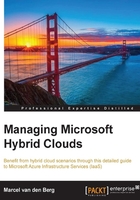
Windows Server 2012
Windows Server 2012 and more specifically the Hyper-V role is the core of the Microsoft hybrid cloud. It will run on-premises in enterprises and in datacenters operated by service providers.
Hyper-V is now a mature hypervisor that offers essential features for the enterprise. Hyper-V is available for free in a product named Microsoft Hyper-V Server 2012. Once installed on a server and booted, a basic command shell interface is presented.
There is no graphical user interface available and no other roles can be installed. However, there are no restrictions from a Hyper-V point of view. All features available in Hyper-V can be used, including clustering, the High Availability feature of Hyper-V. A host running Hyper-V Server can be managed using System Center Virtual Machine Manager. Also this edition does not have the free Windows Server licenses that can be used in the guest operating systems.
For central management of Hyper-V hosts and the virtual machines running on those hosts either Cluster Manager or System Center Virtual Machine Manager can be used. While Cluster Manager offers some basic features, System Center Virtual Machine Manager offers additional features to manage storage, networking, templates, services, role-based management, deployment of physical servers, and a lot more.
System Center Virtual Machine Manager cannot be purchased separately. It comes as part of the System Center Suite. Other components of the System Center Suite are Data Protection Manager, Configuration Manager, Operations Manager, Orchestrator, Endpoint Protection, App Controller, Service Manager, and Windows Azure Pack. An alternative to purchasing the complete System Center suite is purchasing a solution like 5Nine Manager for Hyper-V. This is an easy-to-use and cost-effective management solution for Microsoft Hyper-V. It provides most of the features of Microsoft System Center VMM that SMBs need for everyday Hyper-V management.